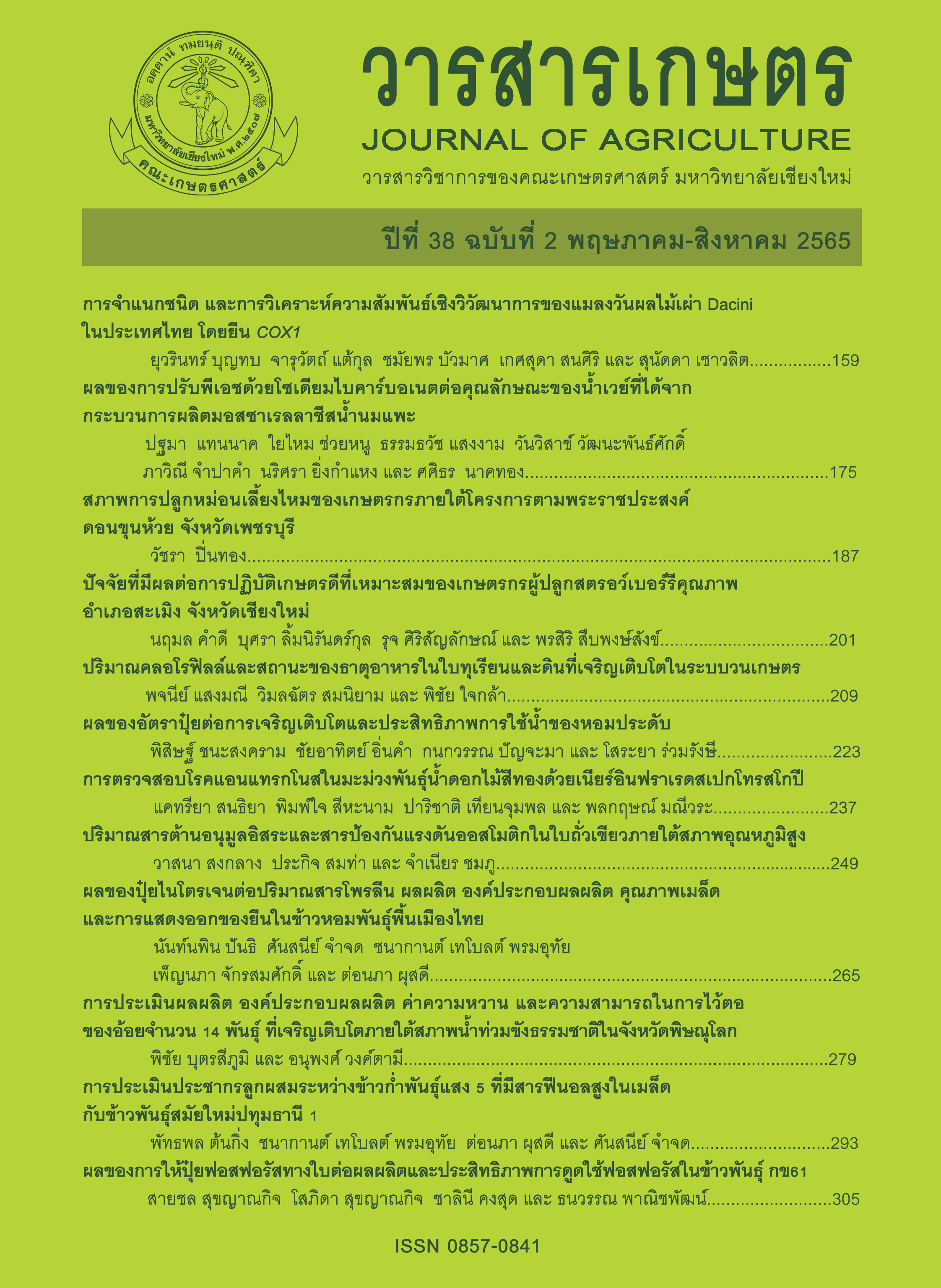การประเมินผลผลิต องค์ประกอบผลผลิต ค่าความหวาน และความสามารถในการไว้ตอของอ้อยจำนวน 14 พันธุ์ที่เจริญเติบโตภายใต้สภาพน้ำท่วมขังธรรมชาติในจังหวัดพิษณุโลก
Main Article Content
บทคัดย่อ
ในสภาวะเครียดจากน้ำท่วมขังส่งกระทบต่อผลผลิต องค์ประกอบผลผลิต และความสามารถในการไว้ตอของต้นอ้อย การศึกษานี้มีวัตถุประสงค์เพื่อประเมินผลผลิต องค์ประกอบผลผลิต และความสามารถในการไว้ตอของอ้อยจำนวน 14 พันธุ์ ในฤดูอ้อยปลูกและอ้อยตอ 1 วางแผนการทดลองแบบ RCBD จำนวน 4 ซ้ำ ปลูกอ้อยแต่ละพันธุ์ในแปลงย่อยที่มีขนาด 1.65 x 10 เมตร จำนวน 4 แถว พบว่า อ้อยพันธุ์ KPS 07 - 17 - 83, KK07 - 599 และ KPS 07 - 21 - 4 ให้ผลผลิตอ้อย และผลผลิตน้ำตาลสูงกว่าอ้อยพันธุ์เปรียบเทียบมาตรฐาน KK3 และ LK92 - 11 ในสภาวะน้ำท่วมขังธรรมชาติของฤดูอ้อยปลูก (29 และ 9 เปอร์เซ็นต์ ตามลำดับ) และอ้อยตอ 1 (23 และ 7 เปอร์เซ็นต์ ตามลำดับ) นอกจากนี้พันธุ์ KPS 07 - 17 - 83 และ KK07 - 599 มีศักยภาพที่ให้องค์ประกอบผลผลิตทุกลักษณะสูงที่สุดในทั้งสองฤดูปลูก ดังนั้น อ้อยพันธุ์ KPS 07 - 17 - 83, KK07 - 599 และ KPS 07 - 21 - 4 ควรได้รับการส่งเสริม หรือใช้เป็นพันธุ์ทางเลือกให้เกษตรกรในท้องถิ่นที่ประสบปัญหาน้ำท่วมขังธรรมชาติในแปลงปลูกอ้อยในจังหวัดพิษณุโลกได้เลือกปลูกต่อไป
Article Details

อนุญาตภายใต้เงื่อนไข Creative Commons Attribution-NonCommercial-NoDerivatives 4.0 International License.
เอกสารอ้างอิง
Ahmed, A.O., A. Obeid and B. Dafallah. 2010. The influence of characters association on behavior of sugarcane genotypes (Saccharum spp.) for cane yield and juice quality. World Journal of Agricultural Sciences 6(2): 207-211.
Arpornrat, P. and U. Jakrarat. 2012. Crop rotation planting in sugarcane field for soil improvement and increasing cane yield in the Northeast. Khon Kaen Agriculture Journal 40(Suppl. 3): 163-170. (in Thai)
Chaudhary, R.R. and B.K. Joshi. 2005. Correlation and path coefficient analyses in sugarcane. Nepal Agriculture Research Journal 6: 24-27.
Drew, M.C. 1997. Oxygen deficiency and root metabolism: Injury and acclimation under hypoxia and anoxia. Annual Review of Plant Physiology and Plant Molecular Biology 48: 223-250.
Gomathi, R. and K. Chandran. 2009. Effect of water logging on growth and yield of sugarcane clones. Sugarcane Breeding Institute (SBI-ICAR) Quarterly News Letter 29(4): 1-2.
Gomathi, R. and K. Chandran. 2013. Juice quality as influenced by water-logging stress in sugarcane. pp. 411-412. In: Proceedings of National Conference of Plant Physiology 2013 on “Current Trends in Plant Biology Research”. Directorate of Groundnut Research, Junagadh, Gujarat.
Gomathi, R., P.N.G. Rao, K. Chandran and A. Selvi. 2015. Adaptive responses of sugarcane to waterlogging stress: An overview. Sugar Tech 17(4): 325-338.
Islam, M.S., M.A.S. Miah, M.K. Begum, M.R. Alam and M.S. Arefin. 2011a. Growth, yield and juice quality of some selected sugarcane clones under water-logging condition. World Journal of Agricultural Sciences 7(4): 504-509.
Islam, M.S., M.A.S. Miah, M.K. Begum, M.R. Alam and M.S. Arefin. 2011b. Biochemical studies of juice quality and yield performance of some promising sugarcane clones under water-logging stress condition. Journal of Agroforestry and Environment 5(1): 87-90.
Jaiphong, T., J. Tominaga, K. Watanabe, M. Nakabaru, H. Takaragawa, R. Suwa, M. Ueno and Y. Kawamitsu. 2016. Effects of duration and combination of drought and flood conditions on leaf photosynthesis, growth and sugar content in sugarcane. Plant Production Science 19(3): 427-437.
Joseph, R., S. Reed, T. Ayala-Silva and B. Glaz. 2011. The effects of natural and induced short-term floods on four sugarcane accessions. International Sugar Journal 113: 207-213.
Malik, S.S. and B.S. Tomer. 2003. Sugarcane varietal performance under high water-logging conditions. Indian Sugar 53(8): 585-588
Milligan, S.B., K.A. Gravois and F.A. Martin. 1996. Inheritance of sugarcane ratooning ability and relationship of younger crop traits to older crop traits. Crop Science 36(1): 45-50.
National Statistical Office. 2020. Rainfall statistics at the meteorological station in 2016-2020 in Phisanulok (Online). Available: http://service.nso.go.th/nso/web/statseries/statseries27.html. (December 14, 2020). (in Thai)
Office of the Cane and Sugar Board. 2020. Report of sugarcane production in Thailand in 2019-20. (Online). Available: http://www.ocsb.go.th/upload/journal/fileupload/923-1854.pdf. (August 14, 2020). (in Thai)
Palachai, C., P. Songsri and N. Jongrungklang. 2019. Comparison of yield components of sugarcane varieties grown under natural short- and long-term water-logged conditions in Thailand. SABRAO Journal of Breeding and Genetics 51(1): 80-92.
Taiz, L. and E. Zeiger. 2002. Plant Physiology. 3rd ed. Sinauer, Sunderland.
Tetsushi, H. and M.A. Karim. 2007. Flooding tolerance of sugarcane in relation to growth, physiology and root structure. South Pacific Studies 28(1): 9-22.
Thongviang, V., T. Buphasorn, D. Somrak, P. Phasook, S. Chaluthong, W. Sensai, P. Kokkan, S. Roobsom, O. Yatabe and K. Niimi. 2014. Comparative study of new U-thong sugarcane varieties and locally cultivated varieties in Kumphawapi district, Udon Thani province. Khon Kaen Agricultue Journal 42(2): 231-238. (in Thai)
Tyagi, A.P. and P. Lai. 2007. Correlation and path coefficient analysis in sugarcane. South Pacific Journal of Natural Science 1: 1-10.
Unigarro Munos, C.A., J.I. Victoria Kafure and O.E. Checa Coral. 2013. Evaluation of aerenchyma radical area in sugar cane (saccharum spp.) as feature of tolerance to hypoxia. Acta Agronomica 62(3): 223-231.
Zhao, D. and Y.-R. Li. 2015. Climate change and sugarcane production: Potential impact and mitigation strategies. International Journal of Agronomy, Article ID 547386, doi: 10.1155/2015/547386.


